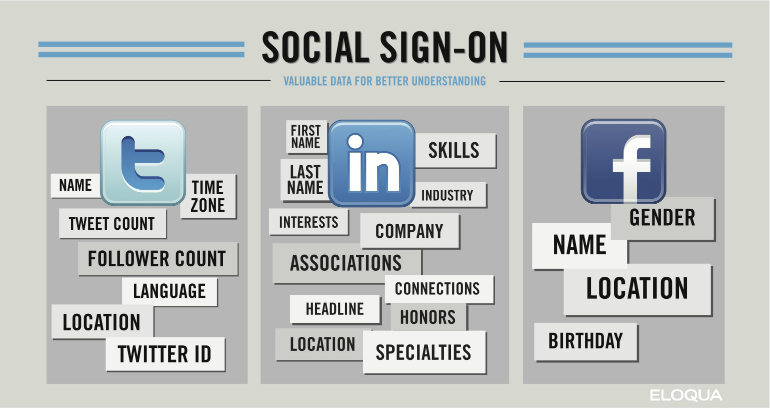Social sign-in (also known as social sign-on and social login) is a simple concept: instead of filling in yet another form, a user simply agrees to sign in using their credentials from a social network.
It’s quick and easy – in fact, if they’ve already signed in to the platform in question, it involves one, or at the most two, clicks. In itself, this isn’t a new idea. We’ve been signing up to sites with our Facebook details for a while now, and even before that, Windows Live / Microsoft ID sign-in was commonly used. Now these two have been joined by Twitter, and also LinkedIn, meaning that almost the entire online population has the option to use social sign-in if they choose to.

The addition of these platforms has made things far more interesting from a B2B perspective, especially when you combine social sign-in with marketing automation, and even more so if LinkedIn is the chosen platform. From a technical point of view, social sign-in involves calling on a platform’s API in order to pull the requested login details from their database – the user gives LinkedIn (or another platform) permission to tell you about them and store the details transferred. What is exciting for B2B marketers is that, depending on the platform, the data available for transfer far surpasses what is usually required to complete a typical registration form. It’s also more likely to be accurate – and it’s social.
Let’s look in more detail at the what social sign-in can deliver:
Higher Conversion Rate
According to PayPal, the average internet user has as many as 25 different separate online accounts and 6-7 different passwords. Helping them to avoid the hassle of setting up that 26th account should guarantee a greater number of form conversions.
Data Accuracy
A prospect is far more likely to have entered accurate personal data on a social media platform than when simply filling in a form in order to download a piece of content. LinkedIn for example is a virtual business window on the world for many people, and they don’t want to be caught out lying by friends, colleagues – or future colleagues, for that matter. This is particularly useful for filling hard to verify fields such as ‘job title’.
Useful profiling data
Sticking to LinkedIn, the data a business can potentially collect includes job description, skills, and specialties. When looking for the ideal contact within an organization, such information can prove invaluable, as it would normally be gathered over time via either desk research or phone calls.
Social profiling data
Confirming that a prospect has a LinkedIn account is already useful. Add to this the number of connections they have, plus the number of recommendations they have received, details of their interests and associations and your sales team suddenly has a different level of information to help them make a connection from the first call they make.
So how can social sign-on revolutionize demand generation?
It’s now universally agreed that social media has already changed the way B2B buyers research and evaluate products and services. Decision makers are searching for information and discussing issues with others, and B2B marketers are therefore looking for ways to engage them in this new arena. But this is easier said than done. To use a ‘real world’ social parallel, you can’t just roll up to any old party and start talking to people. You need common ground, a reason to engage them, ideally an invitation.
Lead nurturing is all about understanding your prospect’s business pains and interest areas so you can position your products and services in a relevant way at the right time. To date this understanding has been gained by studying and analyzing a prospect’s digital body language – what a user clicks on, what they read, what they download – as well as the information they provide through forms and other means of data capture. Social sign-in takes things to a new level, enabling marketers to gather Social Intelligence, the information they need in order to join their prospects’ social media ‘party’ and to start observing how they interact with you and others in the wider social world.
There are of course challenges in collecting, storing and using all this new information. How can data be normalized so that it can usefully populate existing data fields, and where might new fields need to be created? In a recent data audit for one client, the MarketOne team encountered no less than 29,000 different values in the title field alone. Will data from LinkedIn add yet more – totally valid, but new titles? And how can this new social intelligence be acted upon? Should scoring programs be adjusted to take account of new data points, can business rules be applied to determine how an individual should be treated based on their social behavior, or is further human intervention necessary to analyze and interpret correctly?
It’s not enough simply to deploy social sign-in. You need to do so with a planned approach:
1. Define the data you are going to capture
Like the child in the sweet shop, it’s tempting to grab everything, but take the time to work out what will genuinely improve your understanding of a prospect.
2. Ensure your database is ready to store this new data
– and in a way that it can be analyzed and manipulated. Bear in mind at this point that many users of Facebook register under a personal email address and may never have entered their business one. In the case of LinkedIn and Twitter, funnily enough the email address is the one field that is not passed across, so it will be necessary to collect this separately as part of the process.
3. Normalize the data
We managed to translate those 29,000 different titles into a manageable number via an automated process using fuzzy logic, and the same can be done for the key data gathered from LinkedIn.
4. Use the data to score and route prospects
For instance, a score could be attributed to the number of LinkedIn connections a prospect has, and the groups they contribute to could help define which nurture stream is most relevant for them.
5. Where possible, use initial email touches to validate assumptions
you have made based on social data. Further interaction with email and website content can confirm a prospect’s interest in a particular topic.
6. Train your tele-qualification team
on what to look for within a social profile to deepen their understanding of a prospect. And importantly, how they can use this understanding to initiate more meaningful conversations – without appearing like a cyber-stalker.
The integration of social sign-in with marketing automation platforms is relatively new, and the possibilities have only been skimmed. It is, however, a no-brainer for anyone looking to improve the way they gather data – a recent study by Aberdeen Group revealed that 21% of best-in-class companies are already using social sign-in.


